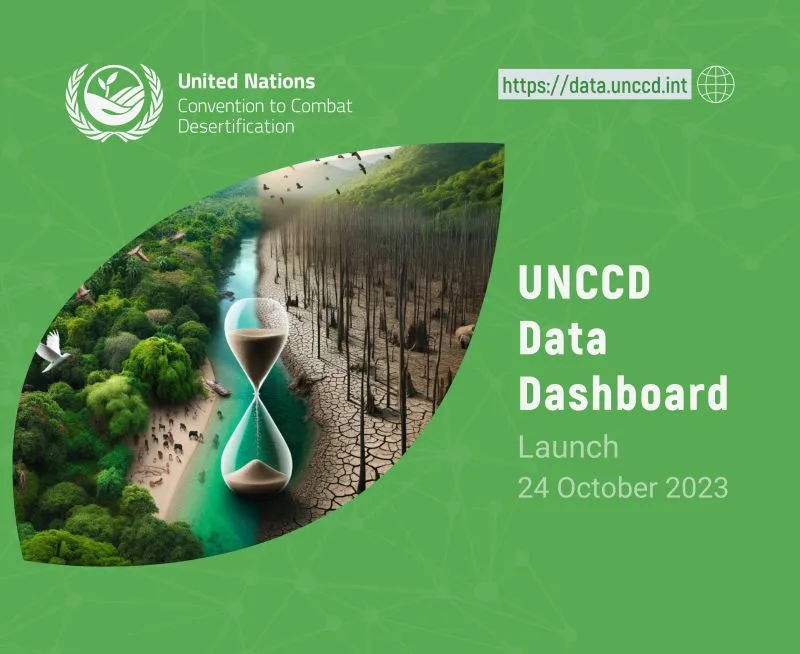UN Convention to Combat Desertification (UNCCD) launched its first-ever Data Dashboard
the first-ever UNCCD Data Dashboard offers an eye-opening insight into rapid loss of healthy and productive land around the world, with dire consequences for billions of people. At the same time, we are seeing some ‘brightspots’—countries effectively tackling desertification, land degradation and drought. As we gather in Uzbekistan next month to review global progress towards ending land loss, the message is clear: land degradation demands immediate attention.
Regional disparities
The UNCCD Data Dashboard reflects an alarming reality across the globe and reveals significant disparities when it comes to the proportion of degraded land per region.
Eastern and Central Asia, and Latin America and the Caribbean regions experience the most severe degradation, affecting at least 20 per cent of their total land area.
Meanwhile, sub-Saharan Africa, Western and Southern Asia, and Latin America and the Caribbean experienced land degradation at rates faster than the global average.
Notably, in sub-Saharan Africa and in Latin America and the Caribbean, 163 million hectares and 108 million hectares, respectively, have succumbed to land degradation since 2015.
Land restoration “brightspots”
Despite a bleak global picture, there are examples of countries effectively tackling desertification, land degradation and drought.
In sub-Saharan Africa, Botswana reduced land degradation from 36 per cent to 17 per cent of its territory. The country has committed a total of 45.3 million hectares to land degradation neutrality, including both measures to avoid further degradation as well as restoration interventions in selected land degradation hotspots. Botswana also reported 1.42 million hectares as “brightspot” areas, or areas that have been rehabilitated by implementing appropriate remediation activities.
In the Dominican Republic, the proportion of degraded land has decreased from 49 per cent to 31per cent between 2015 and 2019, with ongoing efforts to restore 240 000 hectares in the Yaque del Norte River basin and in cocoa production areas in San Franscisco de Macoris province.
While Uzbekistan reported the highest proportion of degraded land (26.1 per cent) in the Central Asia region, it also saw the largest decrease – from 30 per cent to 26 per cent — compared to 2015. A total of 3 million hectares of land in Uzbekistan have been degraded due to the drying of the Aral Sea. Between 2018-2022, Uzbekistan carried out saxaul planting on an area of 1.6 million ha to eliminate salt and dust emissions from the drained bottom of the Aral Sea.
Land degradation neutrality goal still within reach
Although land degradation trends vary by region, UNCCD data warns that, if current trends persist, the world will need to restore a staggering 1.5 billion hectares of degraded land by 2030 to reach LDN targets enshrined in the Sustainable Development Goals (SDGs).
It compiles national reporting figures from 126 countries, which shows that land degradation is advancing at an astonishing rate across all regions.
Key findings
- Between 2015 – 2019, at least 100 million hectares of healthy and productive land were degraded every year.
- India’s 9.45 percent reported land area is degraded.
- Between 2016 – 2019, 50.49 percent of global reported land area and 36.8 percent of India’s land area is affected by
drought. - Eastern and Central Asia, and Latin America and Caribbean regions experience the most severe degradation.
Land degradation is the deterioration or loss of productive capacity of the soils for present and future.
- 109 countries have set voluntary Land Degradation Neutrality (LDN) targets for 2030.
- LDN is a state whereby the amount and quality of land resources necessary to support ecosystem functions and services to enhance food security remain stable, or increase, within specified ecosystems.
India’s Initiative for Land Degradation
- India joined voluntary Bonn Challenge pledge to bring into restoration 26 million hectares of degraded and deforested land by 2030.
- Desertification and Land Degradation Atlas of India (published by ISRO), for state-wise areas of degraded land.
About UN Convention to Combat Desertification (UNCCD)
Genesis:Established in 1994.
About: It is the only legally binding framework set up to address desertification and effects of drought.
Members: 197 Parties to Convention, including 196 country Parties and European Union.
♦ India is a signatory to UNCCD. Ministry of Environment, Forest and Climate Change is nodal Ministry that oversees implementation of Convention in country.
Read About: Accelerated Ice Melt in West Antarctica Unstoppable, Research Suggests

